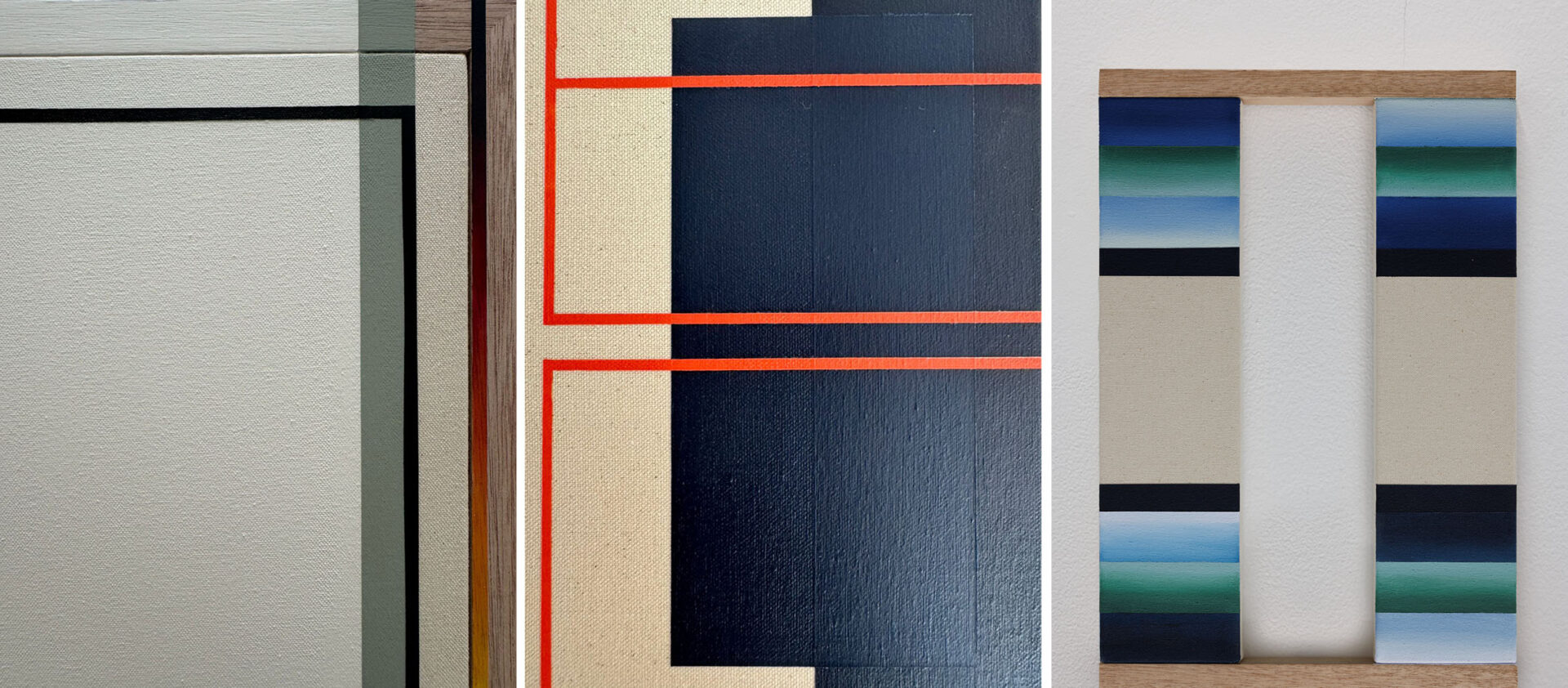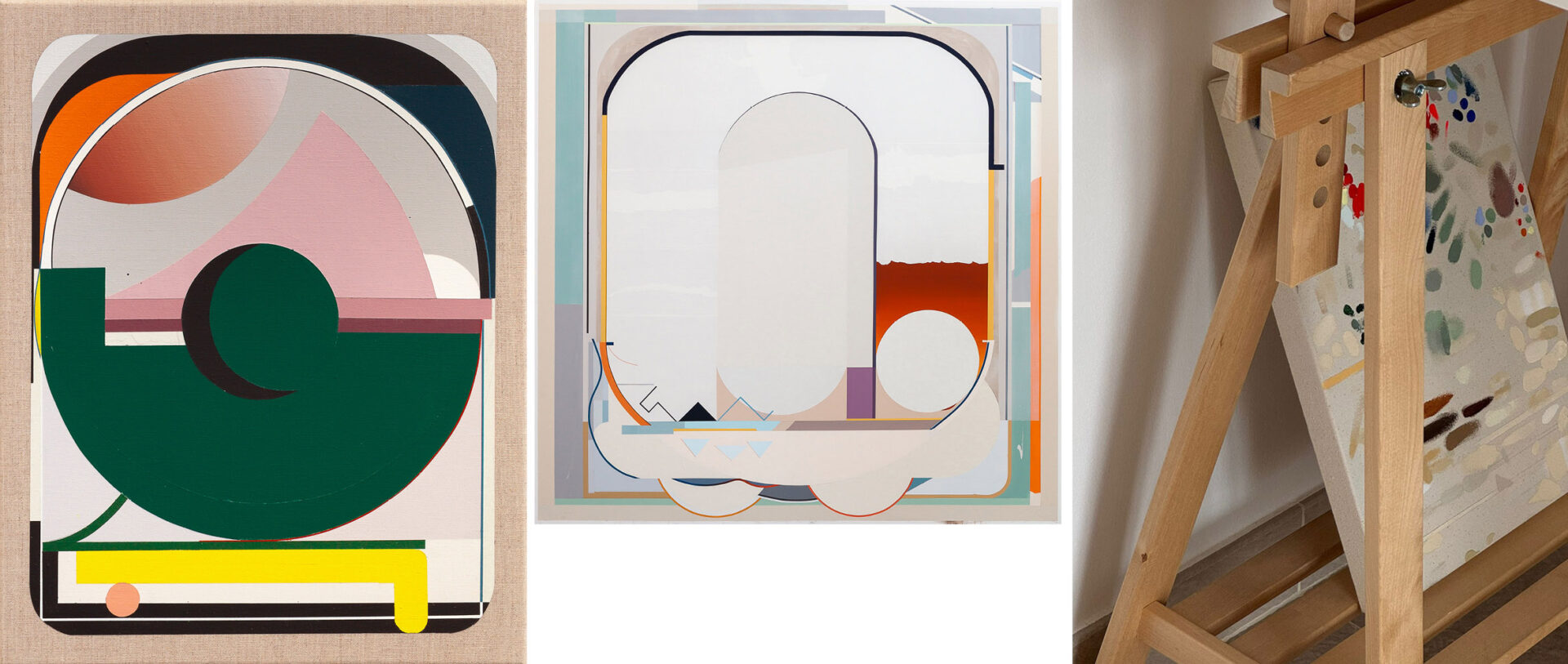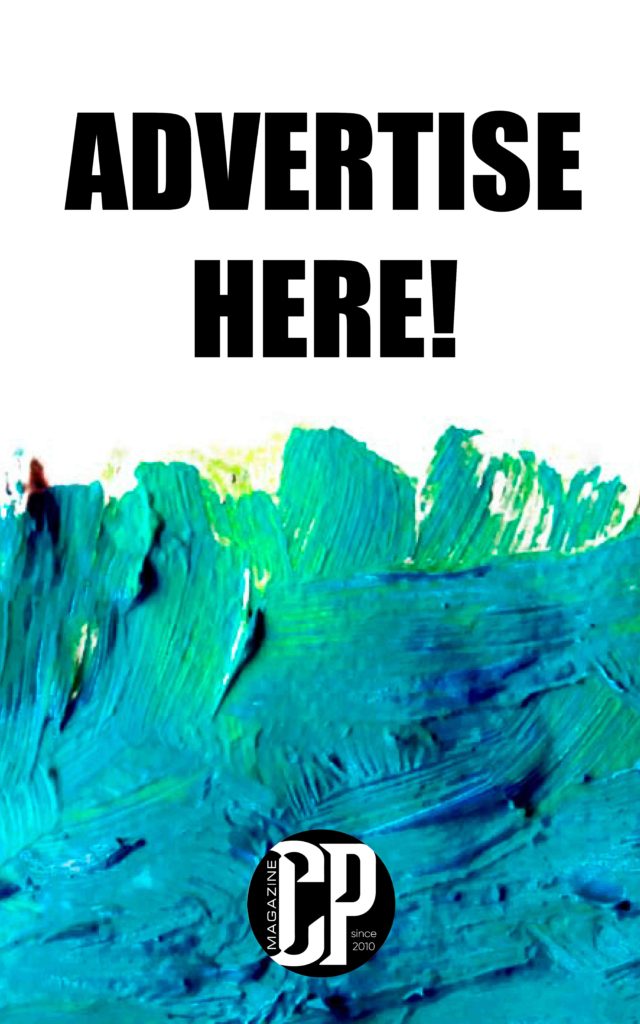Sarah Almehairi and Bernhard Buhmann’s recent works explore “errantry,” as described by Édouard Glissant—a journey of rebellious misdirections and unexpected discoveries. Almehairi layers marks to embrace imperfection, creating sculptural surfaces, while Buhmann’s wounded portraits reflect vulnerability and erasure. Both blur boundaries through fragmented lines, trompe l’oeil effects, and gradations of color, inviting viewers to explore the beauty within unpredictability and transformation.

The recent works of Sarah Almehairi and Bernhard Buhmann present a captivating journey through artistic evolution, grounded in what philosopher Édouard Glissant terms a “poetics of errantry”—a philosophy of adventurous wanderings and rebellious misdirections. Both artists, through their unique visual languages, engage with this idea by crafting narratives that break free from linear progression and established frameworks, embarking instead on unpredictable routes. These errant trajectories take us beyond the known, inviting us to explore uncharted territories where elements of their past works surface and dissolve, creating a rich interplay between memory and transformation.
Almehairi’s and Buhmann’s shared interest in destabilizing the familiar is at the heart of this new phase in their artistic practice. In Almehairi’s work, this takes the form of an intricate layering process that builds upon itself, generating a sense of motion and complexity. Her current focus on overlapping appendages amplifies a long-standing awareness that every surface—no matter how seemingly flat—possesses an inherent sculptural quality. Through an intuitive process of marks and layers, she constructs paintings that feel alive, shifting and changing as they accumulate. This layering effect generates an aesthetic experience that is at once deliberate and fluid, offering no clear resolution but instead a meditative engagement with the passage of time and the phenomena of roots, silence, and even celestial bodies.

Almehairi’s approach to measurement and form draws subtle yet distinct connections to 20th-century minimalist practices, especially the grid-like compositions of Agnes Martin. However, while Martin’s grids often carry an underlying sense of rationality and order, Almehairi’s measurements lead to no such conclusion. Her use of line and form deliberately emphasizes the imperfect, the uneven, and the asymmetrical, suggesting a world where symmetry and balance are less important than the quiet beauty found in irregularities and the unknown. Her work invites viewers to reconsider their understanding of geometry and space, using measurements as a means of probing deeper into the phenomena that shape the natural world—roots, weights, silence, footsteps, and more—while reframing these elements from an entirely fresh perspective.
In contrast, Bernhard Buhmann’s latest works demonstrate an opposite approach, defined by a process of erasure and removal. His mechanical-biomorphic portraits, which have long explored the boundary between the human and the abstract, now bear visible traces of wounds—sickliness, bites, slashes, and teardrops—that reference his ongoing fascination with the dramatic, chiaroscuro-inflected compositions of Caravaggio. Buhmann’s paintings function as evolving characters, each work representing a version of itself that has undergone tribulations. These wounds are not merely decorative; they are symbolic of the artist’s broader inquiry into imperfection and the fragility of the human condition.

Buhmann’s notion of a “detox version” suggests that his portraits have undergone a purification process, one that strips away certain elements to reveal something rawer, more vulnerable, and less mediated. The afflictions that mar his figures speak to an interest in not only the beauty of imperfection but also the physical and emotional scars that come from living in an unpredictable world. His works appear to hover between states of being—between vitality and sickness, abstraction and figuration, reality and imagination—engaging with the same sense of errantry that drives Almehairi’s pieces.
At the core of both artists’ practices is the challenge of reassembling the fragmentations of reality that result from their errant explorations. Glissant’s idea of fugitivity, which complicates the traditional understanding of trompe l’oeil, offers one potential framework for this process. In both Almehairi’s and Buhmann’s paintings, we encounter techniques that blur the boundary between representation and illusion. Painted shadows and torn paper, pictures within pictures, and a confusion between gravity and weightlessness all contribute to a sense of disorientation, forcing the viewer to reconsider their relationship to space and time. These visual strategies mirror the artists’ conceptual engagements with dismantled histories, errant timelines, and the collapse of distance between past and present, offering a multidimensional experience that destabilizes perception.
The use of line in both artists’ works is another key element of their shared aesthetic. In Almehairi’s paintings, lines meander, overlap, and stop abruptly, evoking a sense of fragmentation and interruption, as if the lines themselves are traces of journeys that have been cut short or redirected. This technique speaks to the broader theme of rejected histories—of narratives that are left unfinished or deliberately set aside. Similarly, in Buhmann’s work, lines and forms often emerge as biomorphic shapes that seem to be in a constant state of flux, evolving and adapting as they react to the forces of erasure and mutation.

Color, too, plays a crucial role in the visual and conceptual language of both artists. The artists share a fascination with the possibilities inherent in color gradations, particularly as they offer a way to blur boundaries and establish relationships between forms. In Almehairi’s work, color gradients shift and transform, echoing the fluidity of her layered forms and underscoring the imperfection of linear progression. In Buhmann’s paintings, the use of color often serves to emphasize the emotional and physical states of his figures, with gradients offering a visual metaphor for the transitions between health and illness, vitality and decay.
The designer Ryan Gerald Nelson’s notion of the gradient as a transgressive form provides an insightful lens through which to view the artists’ shared interest in color. Nelson suggests that gradients resist definition, moving and transitioning in ways that defy categorization. This resonates with Buhmann’s and Almehairi’s practices, as both artists are deeply invested in exploring the spaces between defined categories—between abstract and figurative, between rational and intuitive, between wholeness and fragmentation.
Perhaps most intriguingly, the color palettes of Buhmann and Almehairi have recently entered into an unexpected synchronicity. This harmonious convergence of colors, while unplanned, seems to reflect a deeper, almost mysterious connection between the two artists’ practices. Buhmann himself muses on the nature of inspiration, describing it as an inherent quality of painting that operates beyond conscious control. Whether intentional or not, the dialogue between their works offers viewers the opportunity to commune with the “beautiful frailties” and “strange intimacies” that arise from this shared exploration of errantry.
In this joint installation, the interplay between Almehairi’s additive, layered approach and Buhmann’s subtractive, wounded figures creates a dynamic and evolving conversation. Their works, though divergent in process and form, are united by a common commitment to exploring the possibilities that arise when boundaries are blurred, conventions are challenged, and histories are rewritten. Through their errant wanderings, the artists invite us to embrace the unpredictability of the journey and the strange, often beautiful connections that can only emerge through an unplanned encounter.
The show titled ‘The Errantries of Sarah Almehairi and Bernhard Buhmann’ will mark the gallery’s 94th exhibition, set to open on September 18th, and run till November 9th, 2024.








